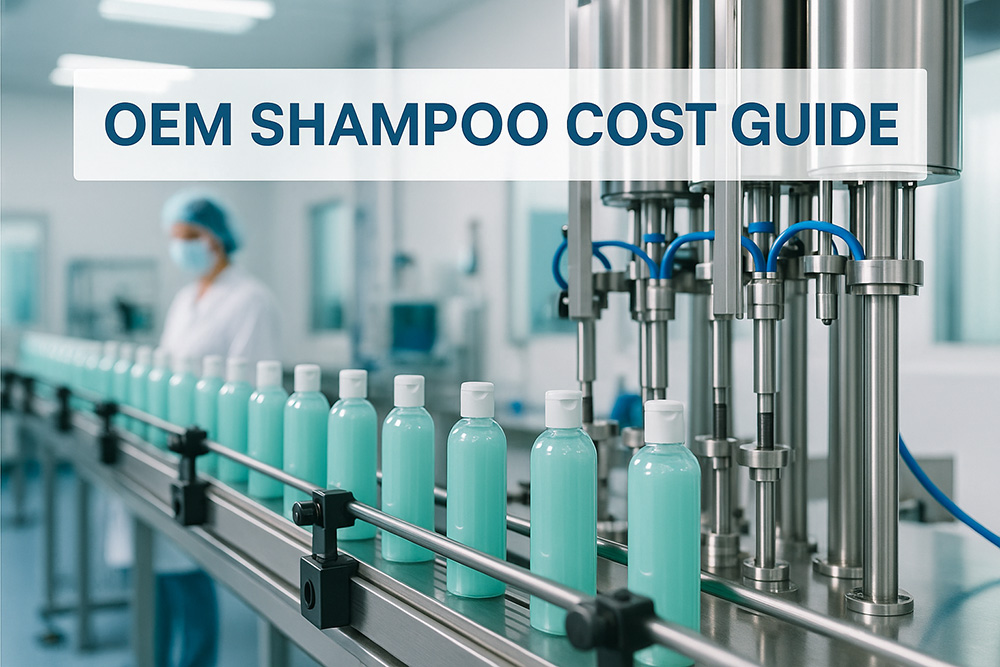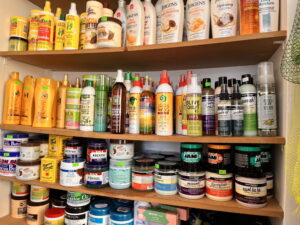OEM Shampoo Cost: From Raw Materials To Finished Products
What drives OEM shampoo cost?
Formula (actives, surfactants, “free-from” claims)
Packaging (material, decoration, molds, MOQs)
Manufacturing (batch size, fill speed, QA)
Compliance (testing, safety assessments, registrations)
Logistics & Incoterms (EXW vs FOB vs DDP, freight, duties)
Use the equation:
EXW Unit Price ≈ (Formula $/kg × Fill weight kg) + Primary packaging + Filling/Label + QC allocation + Setup amortization + Factory margin
OEM vs ODM vs White Label
OEM (Original Equipment Manufacturer): You bring the concept and brand; the manufacturer produces to your spec (customizable formula/packaging).
ODM: Manufacturer provides ready-to-customize base formulas/packaging; you brand and tweak. Faster/cheaper than full custom.
White Label: Pre-made product with minimal changes (logo/label). Fastest to market; least unique.
For ranking: Throughout this guide, we’ll use “OEM Shampoo” intentionally in headings and copy to reinforce topical relevance.
Cost Stack Overview
Formula (BOM): surfactant system, conditioners/silicones or silicone-free alternatives, actives (e.g., caffeine, peptides), fragrance, color, preservatives, chelators, rheology/pearling agents, water.
Primary Packaging: bottle/tube/pouch, closure (flip-top, disc, pump), labels or print, inserts/wads.
Secondary Packaging: cartons, dividers, shrink-wrap, master cases.
Manufacturing: batching, filling, capping, labeling, line changeovers, cleaning, waste.
Quality & Compliance: stability/micro tests, claims substantiation, safety reports.
One-time/Amortized: mold/tooling, artwork pre-press, pilot batches.
Logistics: inland freight, export docs, ocean/air, insurance, duties, last-mile.
Formula Cost (BOM) Explained
Big drivers:
Surfactant choice: Sulfate systems are cost-efficient; sulfate-free (e.g., glucosides, isethionates) cost more.
Conditioning approach: Silicones (e.g., dimethicone, amodimethicone) are economical; silicone-free or “natural origin” conditioners trend higher.
Actives & claims: Anti-dandruff actives, caffeine/biotin/peptides, botanical complexes, fragrance allergens compliance (IFRA) can lift cost.
Color/fragrance: Custom fragrances, allergen-restricted palettes, or high oil load increase cost.
Clean/green standards: “Vegan,” “EWG-friendly,” “COSMOS-approvable” inputs push BOM up.
Rule of thumb (illustrative ranges, ex-works):
Basic daily-use OEM shampoo: \$1.2–\$3.5/kg
Performance/sulfate-free: $3.5–$8/kg
Premium/active-rich or natural-cert-ready: $8–$15+/kg
Quick math: 300 mL fill ≈ 0.30 kg. Formula cost per unit = Formula $/kg × 0.30.
Packaging Cost Levers
Material: PET < HDPE < PP < PCR content < Glass/Aluminum (generally).
Closure: Flip-top/disc caps are economical; pumps/lock pumps cost more.
Decoration: Pressure-sensitive label (1–2 colors) < screen print < hot-stamp/metallic < sleeve.
Coloring: Custom masterbatch, opaque/soft-touch, and heavy tints add.
Tooling: Custom bottle molds (one-time) vs stock molds (no tooling).
MOQ: Labels as low as 1–3k; custom bottles often 10k+ for best pricing.
Indicative per-unit ranges (300 mL, large orders):
Stock PET bottle + flip cap: $0.12–$0.22
Label (single): $0.03–$0.08
Pump upgrade: +$0.15–$0.35
Manufacturing & Overheads
Batching: labor, energy, cleaning, yield losses.
Filling/Labeling: line speed (bpm), changeovers, rejects.
QA/QC: in-process checks, finished-goods testing.
Allocation: setup fees amortized over run size (hurts small MOQs).
Typical allocations (illustrative): filling/labeling $0.07–$0.18 per unit; QA allocation $0.03–$0.06.
Compliance, Testing & Claims
Stability & compatibility: real-time/accelerated, packaging interaction.
Microbiology: preservative efficacy (challenge), total plate counts.
Safety: CPSR/assessor reports (EU/UK), IFRA compliance, SDS.
Regulatory: INCI, allergens labeling, CPNP (EU), FDA VCRP (voluntary), GCC/SASO, etc.
Budget signals: $500–$3,000+ per SKU across essential tests and documents (varies by market/claim depth).
Volume, MOQs & Economies of Scale
MOQ for OEM shampoo commonly 3,000–10,000+ units depending on packaging.
Bigger batches improve raw pricing, reduce setup per unit, and unlock better packaging quotes.
Expect 10–30% unit cost reduction when scaling from low to mid volumes; diminishing returns at very high volumes.
Worked Examples: Three OEM Shampoo Scenarios
Assumptions: 300 mL (≈0.30 kg); EXW pricing; 20% factory margin added to direct costs. Numbers are illustrative for comparison.
What to notice
The same bottle gets cheaper with volume.
Formula complexity dominates cost as claims increase.
Setup amortization crushes small runs—consider ODM/stock packages for your first order.
From EXW to Landed Cost
Incoterms cheat sheet:
EXW: pick up at factory; you handle everything.
FOB: supplier delivers to port and clears export; you handle ocean/air + import.
DDP: supplier delivers to your door, duties paid (usually highest quote, simplest for you).
Landed Cost = EXW/FOB Unit Price + Freight per unit + Insurance + Duty/Tax + Local delivery
Tips: Ship by sea if your timeline allows; optimize CBM (carton design, pack count, bottle geometry).
Lead Times & Project Plan
Brief & RFQ: 2–5 business days
Lab samples (v1): 1–2 weeks
Revisions & pre-production sample: 1–2 weeks
Packaging procurement: 3–6 weeks (stock) / 6–10+ (custom)
Manufacturing & QA: 1–3 weeks
Total to ship: typically 6–12 weeks after approvals (market and seasonality affect this)
RFQ Template (Copy/Paste)
Email subject: RFQ – OEM Shampoo (300 mL, Target EXW/FOB, Region: ___)
Product
Positioning: Daily / Anti-dandruff / Color-safe / Sulfate-free / Silicone-free / Natural-leaning
Hair type & claims: e.g., oily scalp, volumizing, anti-frizz, sensitive
Active targets: e.g., caffeine 0.2%, niacinamide 2%, zinc PCA 0.5%
Fragrance: type, allergen restrictions, IFRA region
Color: none / tinted / pearlized
Texture: viscosity target (cP), clarity (clear/pearl/opaque)
pH window, preservative preferences, “free-from” list
Packaging
Format: bottle/tube; capacity 300 mL; neck/closure type; pump yes/no
Material & color (PCR % if any); decoration (label/screen/sleeve), # of colors
Secondary: unit box? shrink? master case quantity & size constraints
Custom mold? If yes, share drawings & expected annual volume
Order & Commercials
Target MOQ & annual forecast
Incoterm (EXW/FOB/DDP) & destination port
Required certifications (GMP/ISO 22716, cruelty-free, vegan, COSMOS-ready)
Testing & documents needed (stability, challenge, CPSR/CPNP, SDS)
Budget target per unit (range) and launch deadline
Artwork handoff date; barcode & legal text owner
Try Xiangxiang Daily Now!
We Help You Launch New Products, And Continue To Grow. Try Us With 20% Off Your First Order!
Certified OEM/ODM Shampoo Manufacturer
We are a professional OEM/ODM shampoo manufacturer serving brands, distributors, and retailers worldwide. Our plants operate under Good Manufacturing Practice and robust quality systems to deliver stable, compliant, and scalable OEM shampoo production.
Certifications & compliance capabilities (examples):
ISO 22716 (Cosmetics GMP) / GMPC, ISO 9001 quality system; optional ISO 14001 environmental management.
Social compliance audits available (e.g., BSCI/SMETA, upon request).
Regulatory support: U.S. MoCRA-ready documentation, EU CPNP submission support & CPSR (safety assessment), IFRA compliance, SDS/COA/COC issuance.
Testing infrastructure: microbial testing, preservative efficacy (challenge), stability & compatibility (incl. accelerated), packaging interaction, and routine QC checkpoints.
Sustainable sourcing options (e.g., naturally derived surfactants, RSPO MB-eligible inputs, PCR packaging) on request.
If you need a specific certificate list for your retailer or market entry, we’ll provide a tailored compliance pack during the RFQ stage.
Ingredient Families That Move the Cost Needle (Quick Guide)
When planning an OEM shampoo, these ingredient groups most affect cost, sensorials, and claims:
Primary surfactants
Cost-efficient: SLES/ALES + CAPB systems (good foam/clarity).
Premium/sulfate-free: APG/glucosides, isethionates, sarcosinates—milder, higher BOM.
Conditioners & anti-frizz agents
Economical: silicones (dimethicone/amodimethicone), polyquats.
Silicone-free “clean” systems: cationic biopolymers, esters—cost ↑, marketing value ↑.
Scalp & performance actives
Oil-control/soothing: niacinamide, zinc PCA, panthenol, botanical complexes.
Anti-dandruff actives vary by market; regulatory status differs (we’ll tailor regionally).
Rheology/appearance
Salt/Crothix-type thickeners, pearlizing agents, clarity modulators—impact aesthetics and fill behavior.
Preservation & compliance
Phenoxyethanol/organic acids, allergen labeling alignment with IFRA and local rules.
Tip: Anchor one “hero benefit” instead of piling overlapping actives—you’ll control BOM while keeping claims sharp.
Quality-Control & Documentation You Can Expect
Batch-level records: full traceability of raws & packaging, retained samples, COA/COC.
In-process controls: pH/viscosity checks, fill-weight verification, torque/seal integrity.
Finished-goods testing: micro limits, stability checkpoints, leak/drop tests (as briefed).
Regulatory file: INCI lists, SDS, IFRA statements, allergen disclosures, label review.
Change control: formal approvals for any raw/packaging substitution to protect consistency.
Work With Us (Fast-Track Your OEM Shampoo)
Looking for a costed proposal and first lab sample? Share your brief (or use the RFQ template above), and we’ll scope formula options (ODM base vs custom), packaging routes (stock vs custom mold), and lead times.
What we’ll deliver in the quote: formula BOM highlights & claim options, packaging specs & MOQs, per-unit EXW/FOB pricing, compliance/testing plan, and a realistic 6–12 week project timeline from approvals.
Contact us: [Your Email / Webform / WhatsApp]
Preferred details to include: target price band, volume forecast, market(s) of sale, and any “free-from”/certification expectations.
We’re happy to start with an ODM base (fast, cost-predictable) and evolve to a fully custom system once your volumes scale.
Cost Optimization Playbook
Choose an ODM base then customize scent/color/actives—keeps performance high and cost predictable.
Right-size actives: use clinically meaningful but efficient loadings; don’t stack overlapping claims.
Pick stock packaging for first runs; reserve custom molds for >50k/yr volumes.
Simplify decoration: one label, 1–2 colors; avoid multi-pass metallics early.
Bundle SKUs to hit better raw/packaging brackets.
Approve artwork early to avoid rush fees and air-freighting components.
Set realistic specs (viscosity/pH windows) to reduce rejects and rework.
OEM Shampoo FAQ
1) What’s a typical MOQ for OEM shampoo?
Commonly 3,000–10,000 units depending on packaging and formula. Pumps, sleeves, or custom bottles push MOQs higher.
2) How can I lower my OEM shampoo cost without losing quality?
Start with an ODM base, use stock PET + flip cap, keep label simple, and focus on one hero claim rather than stacking many.
3) How long from PO to shipment?
Plan 6–12 weeks after formula & artwork approvals. Packaging lead times are the usual bottleneck.
4) Do sulfate-free OEM shampoos always cost more?
Generally yes—alternative surfactants cost more and may need richer conditioning systems.
5) What hidden costs should I watch?
Tooling, pre-press, pilot batches, extra micro/compatibility rounds, rush fees, and logistics to your warehouse (beyond EXW/FOB).
6) Can I order a concentrate to dilute locally?
Sometimes. It reduces freight but adds local blending/QA complexity—align on specs and responsibilities upfront.
Final Take
If you’re new to OEM shampoo, start with an ODM base formula, pick stock packaging, and order at a volume that clears key price breaks. Use the RFQ template above to get apples-to-apples quotes, then compare formula complexity, packaging choices, and Incoterms to pin down your true landed cost.
Table of Contents
Latest Blog Posts
Check out the latest industry trends and take inspiration from our updated blogs, giving you a fresh insight to help boost your business.





